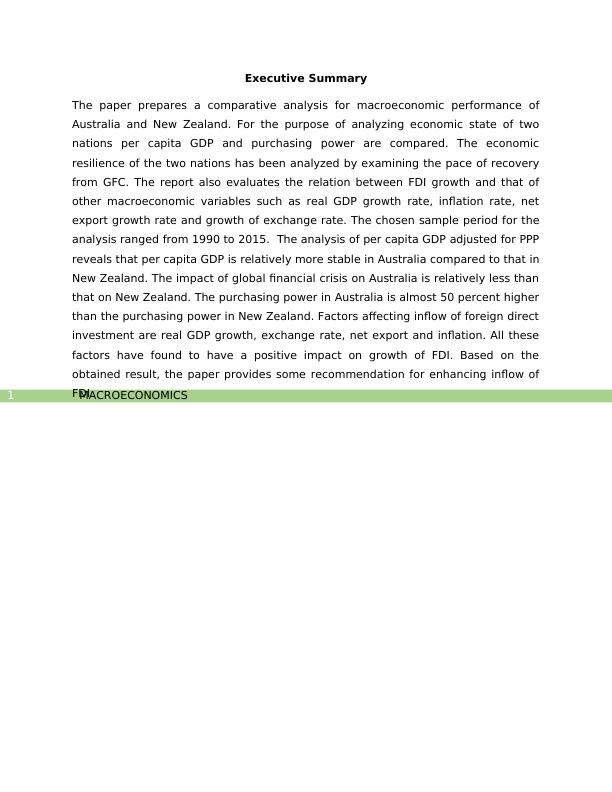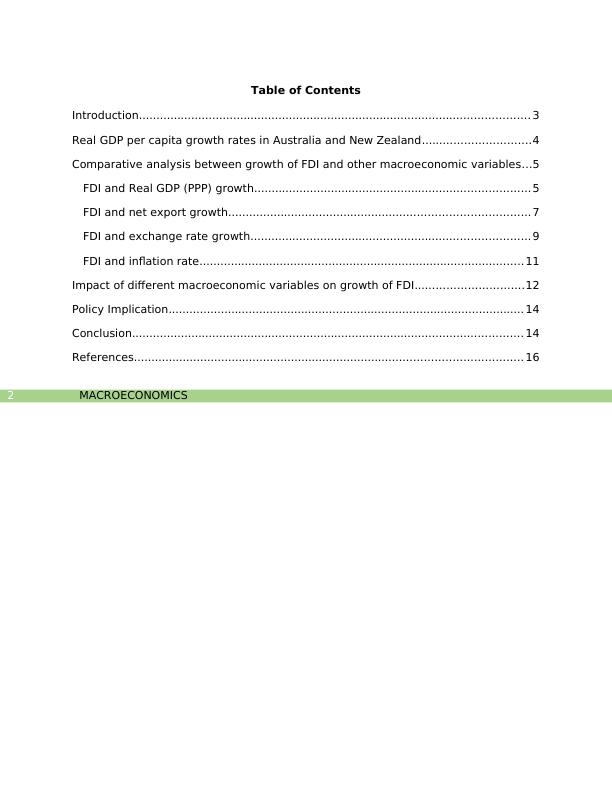Comparative Analysis of Macroeconomic Performance of Australia and New Zealand
Added on 2022-11-13
20 Pages3563 Words292 Views
Running head: MACROECONOMICS
Macroeconomics
Name of the Student
Name of the University
Student ID
Macroeconomics
Name of the Student
Name of the University
Student ID

MACROECONOMICS1
Executive Summary
The paper prepares a comparative analysis for macroeconomic performance of
Australia and New Zealand. For the purpose of analyzing economic state of two
nations per capita GDP and purchasing power are compared. The economic
resilience of the two nations has been analyzed by examining the pace of recovery
from GFC. The report also evaluates the relation between FDI growth and that of
other macroeconomic variables such as real GDP growth rate, inflation rate, net
export growth rate and growth of exchange rate. The chosen sample period for the
analysis ranged from 1990 to 2015. The analysis of per capita GDP adjusted for PPP
reveals that per capita GDP is relatively more stable in Australia compared to that in
New Zealand. The impact of global financial crisis on Australia is relatively less than
that on New Zealand. The purchasing power in Australia is almost 50 percent higher
than the purchasing power in New Zealand. Factors affecting inflow of foreign direct
investment are real GDP growth, exchange rate, net export and inflation. All these
factors have found to have a positive impact on growth of FDI. Based on the
obtained result, the paper provides some recommendation for enhancing inflow of
FDI.
Executive Summary
The paper prepares a comparative analysis for macroeconomic performance of
Australia and New Zealand. For the purpose of analyzing economic state of two
nations per capita GDP and purchasing power are compared. The economic
resilience of the two nations has been analyzed by examining the pace of recovery
from GFC. The report also evaluates the relation between FDI growth and that of
other macroeconomic variables such as real GDP growth rate, inflation rate, net
export growth rate and growth of exchange rate. The chosen sample period for the
analysis ranged from 1990 to 2015. The analysis of per capita GDP adjusted for PPP
reveals that per capita GDP is relatively more stable in Australia compared to that in
New Zealand. The impact of global financial crisis on Australia is relatively less than
that on New Zealand. The purchasing power in Australia is almost 50 percent higher
than the purchasing power in New Zealand. Factors affecting inflow of foreign direct
investment are real GDP growth, exchange rate, net export and inflation. All these
factors have found to have a positive impact on growth of FDI. Based on the
obtained result, the paper provides some recommendation for enhancing inflow of
FDI.

MACROECONOMICS2
Table of Contents
Introduction................................................................................................................ 3
Real GDP per capita growth rates in Australia and New Zealand...............................4
Comparative analysis between growth of FDI and other macroeconomic variables...5
FDI and Real GDP (PPP) growth............................................................................... 5
FDI and net export growth...................................................................................... 7
FDI and exchange rate growth................................................................................ 9
FDI and inflation rate............................................................................................. 11
Impact of different macroeconomic variables on growth of FDI...............................12
Policy Implication...................................................................................................... 14
Conclusion................................................................................................................ 14
References............................................................................................................... 16
Table of Contents
Introduction................................................................................................................ 3
Real GDP per capita growth rates in Australia and New Zealand...............................4
Comparative analysis between growth of FDI and other macroeconomic variables...5
FDI and Real GDP (PPP) growth............................................................................... 5
FDI and net export growth...................................................................................... 7
FDI and exchange rate growth................................................................................ 9
FDI and inflation rate............................................................................................. 11
Impact of different macroeconomic variables on growth of FDI...............................12
Policy Implication...................................................................................................... 14
Conclusion................................................................................................................ 14
References............................................................................................................... 16

MACROECONOMICS3
Introduction
Macroeconomic performance of a nation is evaluated for determining
economic health of the country. Government design various policies to ensure a
stable macroeconomic performance of a nation. Australia is known to have a mixed
developed market economies structure that help the nation to attain a robust
growth rate for a considerable long period of time. There are several factors that
contribute to a steady growth of Australia’s economy. The labor force participation
rate in Australia is high indicating a high rate of employment (Turnbull, Sun and
Anwar, 2016). Higher productivity contributes to a higher growth rate for the
economy. Australia records one of the highest per capita income in the OECD group.
Growing export sector is one of the significant contributor of Australia’s economic
growth. Given steady economic growth and a strong currency, the country attracts
a significant volume of foreign direct investment.
New Zealand in contrast has shifted to an unregulated market economy in
the past few years. The country mainly exports primary or agricultural products.
Tourism industry is one of the significant contributors of economic growth of the
nation. Along with this, dairy exports also make significant contribution for a stable
economic growth (Nolan, Fraser and Conway, 2018) The economy still suffers from a
high unemployment rate. New Zealand shows a large dependency on imports which
raise the living cost in the nation relative to Australia.
The paper prepares a comparative analysis for macroeconomic performance
of Australia and New Zealand. The report also evaluates the relation between FDI
growth and that of other macroeconomic variables such as real GDP growth rate,
inflation rate, net export growth rate and growth of exchange rate.
Introduction
Macroeconomic performance of a nation is evaluated for determining
economic health of the country. Government design various policies to ensure a
stable macroeconomic performance of a nation. Australia is known to have a mixed
developed market economies structure that help the nation to attain a robust
growth rate for a considerable long period of time. There are several factors that
contribute to a steady growth of Australia’s economy. The labor force participation
rate in Australia is high indicating a high rate of employment (Turnbull, Sun and
Anwar, 2016). Higher productivity contributes to a higher growth rate for the
economy. Australia records one of the highest per capita income in the OECD group.
Growing export sector is one of the significant contributor of Australia’s economic
growth. Given steady economic growth and a strong currency, the country attracts
a significant volume of foreign direct investment.
New Zealand in contrast has shifted to an unregulated market economy in
the past few years. The country mainly exports primary or agricultural products.
Tourism industry is one of the significant contributors of economic growth of the
nation. Along with this, dairy exports also make significant contribution for a stable
economic growth (Nolan, Fraser and Conway, 2018) The economy still suffers from a
high unemployment rate. New Zealand shows a large dependency on imports which
raise the living cost in the nation relative to Australia.
The paper prepares a comparative analysis for macroeconomic performance
of Australia and New Zealand. The report also evaluates the relation between FDI
growth and that of other macroeconomic variables such as real GDP growth rate,
inflation rate, net export growth rate and growth of exchange rate.

End of preview
Want to access all the pages? Upload your documents or become a member.
Related Documents
Comparative Analysis of Economic Performance of Australia and New Zealandlg...
|17
|3943
|59
Evaluation of the Macroeconomic Performance of Australia and USAlg...
|13
|3576
|482
BUS700 Economic Assignment: Macroeconomic Performancelg...
|14
|3724
|40
Evaluation of Macroeconomic performance of Australia and USAlg...
|18
|3445
|251
Sample Assignment on Economics USAlg...
|12
|3886
|36
Analysis of Macroeconomic Factors of China's Economic Performancelg...
|12
|3112
|76
